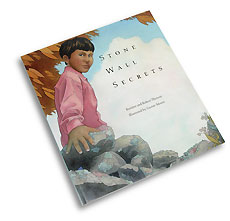For more archives, go to the Advance Archive/Search Page.
Thorsons' Children's Book Springboard
For Science Curriculum
Stone Wall Secrets, a children's book written by a UConn professor and his wife, has become the catalyst for a novel elementary school curriculum that may one day end up in schools throughout the U.S.
The project, made possible by a $150,000 National Science Foundation (NSF) grant, is a joint effort between the Neag School of Education andCollege of Liberal Arts and Sciences faculty.
 |
About six years ago, Robert Thorson, a professor of geology, and his wife Kristine penned a fictional story about a boy, his grandfather, and a stone wall in need of repair. The story is intertwined with lessons about how rocks provide clues to the past, from the days when the earth's crust was formed to tales about the first settlers.
Last year, after a series of meetings designed to encourage collaboration between the two faculties, Thorson approached David Moss, a science educator, and Wendy Glenn, an English educator, with an idea he had for bringing the fictional story to life.
The trio put together a funding proposal that the NSF ranked number one out of more than 60 applications from a national pool.
"People have been developing science curriculum for decades, but our proposal resonated with the NSF," says Moss.
After recruiting teachers from the Mansfield school system, the team developed a pilot curriculum currently being tested in the Goodwin Elementary and Mansfield Middle Schools.
Science is virtually ignored in elementary schools, according to Glenn. "Teachers spend the bulk of their day on language arts, because that is what the student achievement tests focus on," she says.
Using the Thorsons' book as a springboard, they are developing a K-8 curriculum that embeds science within language arts and other disciplines, rather than treating each subject as a separate and distinct content area.
For example, students in a third grade class, engaged in a lesson revolving around life in the colonial days when fields needed to be cleared for farming, posed a simple, but profound question, "Where did all the rocks comes from?"
This became a perfect opportunity for the teacher to move seamlessly between the disciplines, incorporating scientific thinking in an authentic and meaningful way. It became 'a hook,' Moss says, for the students to care about science in the context of real life.
The curriculum will be analyzed and revised as necessary this summer before another year of pilot testing begins. The materials will then be made available to all educators on the NSF website.

